

A Star Note is a note with a Star (✩) in the prefix or suffix position of the serial number. These notes are typically used to replace a note damaged during the printing process to maintain the correct count of notes in a serial number run.
The Bureau of Engraving and Printing inspects currency for printing errors prior to releasing notes into general circulation. When notes are discovered that have been printed incorrectly (such as having the serial numbers upside down, etc.) these misprinted notes (error notes) are replaced with star notes because no two bills can be produced with the same serial number. They are used to maintain a correct count of notes in a serial number run. By their nature, star notes are more scarce than notes with standard serial numbers and as such are widely collected by hobbyists. Some of the highest prices paid for modern (post-1928) U.S. banknotes have been for star notes. A star note is also substituted for the last note in a series rather than printing a note with a serial number consisting of eight zeros. The relative rareness of a star note may be estimated from several sites that categorize the quantity of bills printed in each grouping.
See: Star Note Lookup
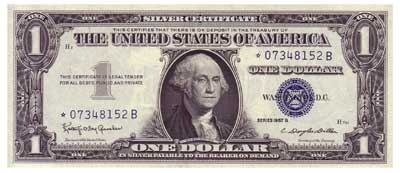 | FR-1621✩, KL-1464✩ - Series 1957 B $1 Silver Certificate, Star Note, Granahan - Dillon, Plate# H741/419, 49,280,000 printed Last Issue of the $1 Silver Certificate — The last delivery of $1 Silver Certificates was made on 06 November 1963. |
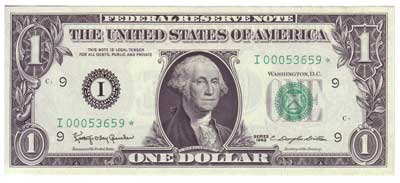 | FR-1900I✩, KL-1473✩ - Series 1963 $1 Federal Reserve Note, Star Note Mule, Minneapolis, Granahan - Dillon, Plate# C7/432, 44,800,000 printed, CH CU+ First issue of the $1 Federal Reserve Note — The first delivery of $1 Federal Reserve Notes was made on 06 November 1963. This is a mule note because it is a new 1963 face plate printed with a 1957 B Silver Certificate back plate (plate number 432). Notice the low serial number! |
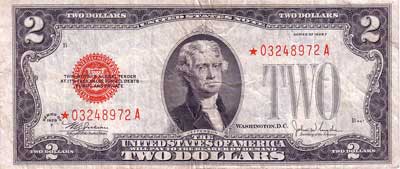 | FR-1507✩ - Series 1928 F $2 United States Note (Legal Tender Note), Star Note, Julian - Snyder,Plate# B447/315 |
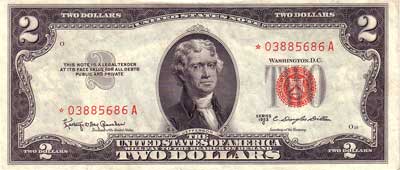 | FR-1512✩ - Series 1953 C $2 United States Note (Legal Tender Note), Star Note, Granahan - Dillon, Plate# O15/410, 360,000 printed |
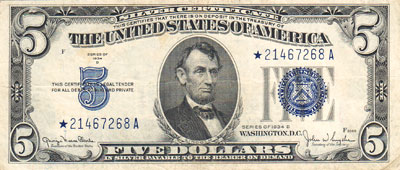 | FR-1654✭ - Series 1934 D $5 Silver Certificate, Clarke - Synder, Plate# F2068/1910 Last of the Series 1934 Silver Certificates Wide 1 Back — For the Series 1934 D $5 Silver Certificate Star Notes with back check numbers 2006 or lower were wide back 1 notes. Notice the star is solid — It changes to a smaller hollow star in the next Series, 1953, when printing was switched from 12-subject sheets to 18-subject sheets. |
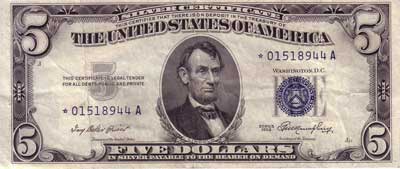 | FR-1655✩ - Series 1953 $5 Silver Certificate, Priest - Humphrey, Plate# J11/2118, 15,120,000 printed New Design for the $5 Silver Certificate Notice the star is now hollow. |
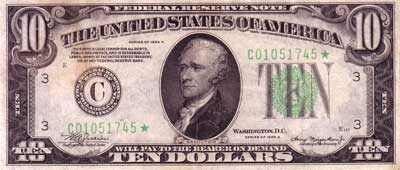 | FR-2006C✩ - Series 1934 A $10 Federal Reserve Note, Star Note, Philadelphia, Julian - Morgenthau Beautiful solid green star! |
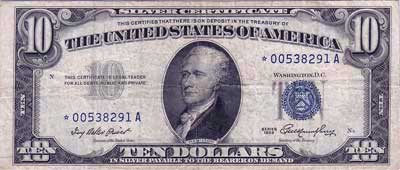 | FR-1706✩ - Series 1953 Silver Certificate, Star Note, Priest - Humphrey, Plate# N3/1631, 576,000 printed, PMG 25 Very Fine |
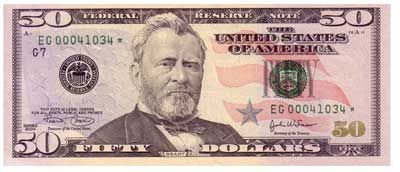 | FR-2128G✩, KL-4758✩ - Series 2004 $50 Federal Reserve Note, Star Note, Chicago, Marin - Snow, Low serial number, Plate# A1/7, 115,200,000 printed, CU Obligation Clause: This note is legal tender for all debts, public and private. |
| Series 2009 A $100 Federal Reserve Note, Star Note, Chicago, Rios - Geithner, Plate# H8/8, S/N LG04727792✩ New Design for the $100 Federal Reserve Note — See The Redesigned $100 Note. The serial number features an initial letter "L" followed by the letter designating the Federal Reserve District — See New Prefix. Just below the serial number on the left side, the district letter and number are printed. |